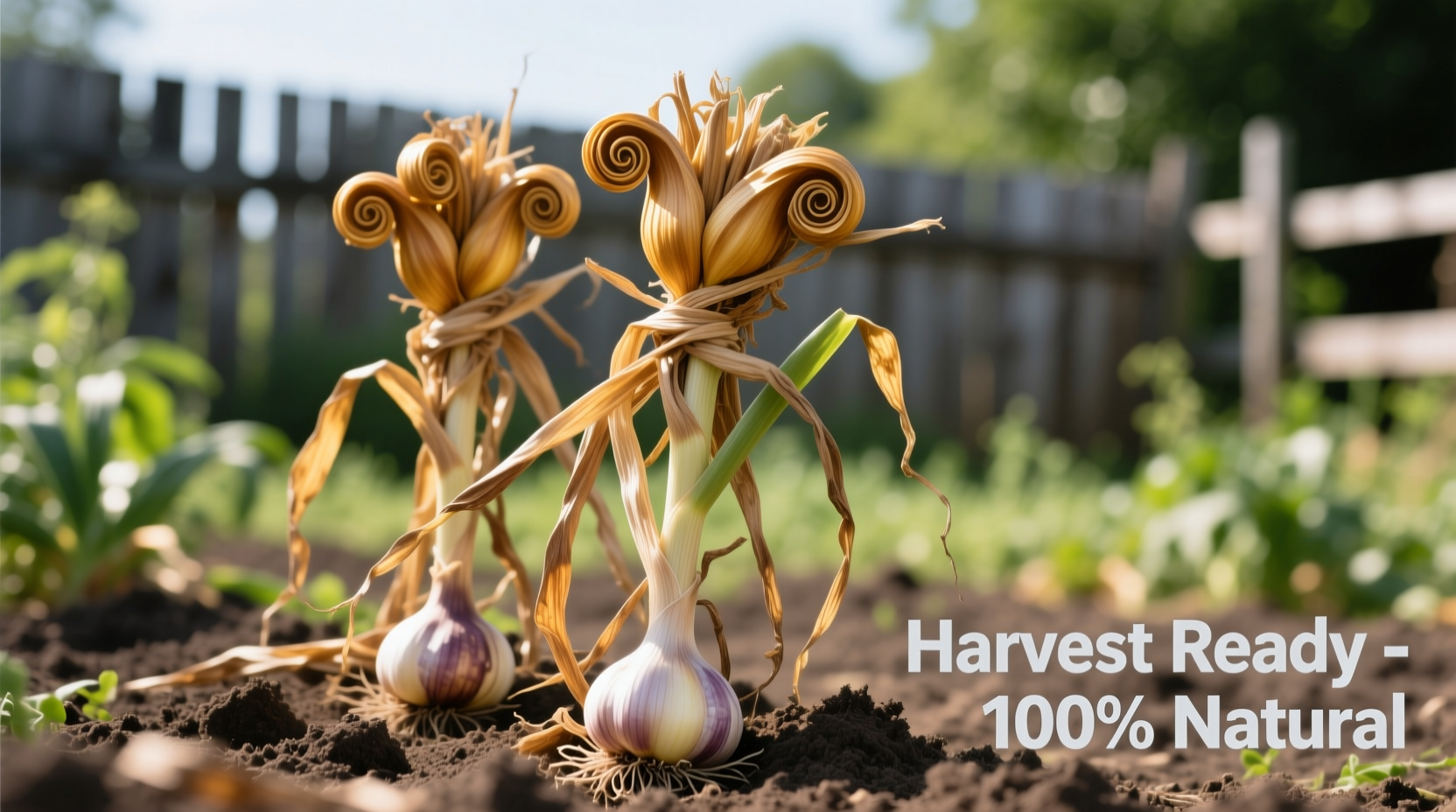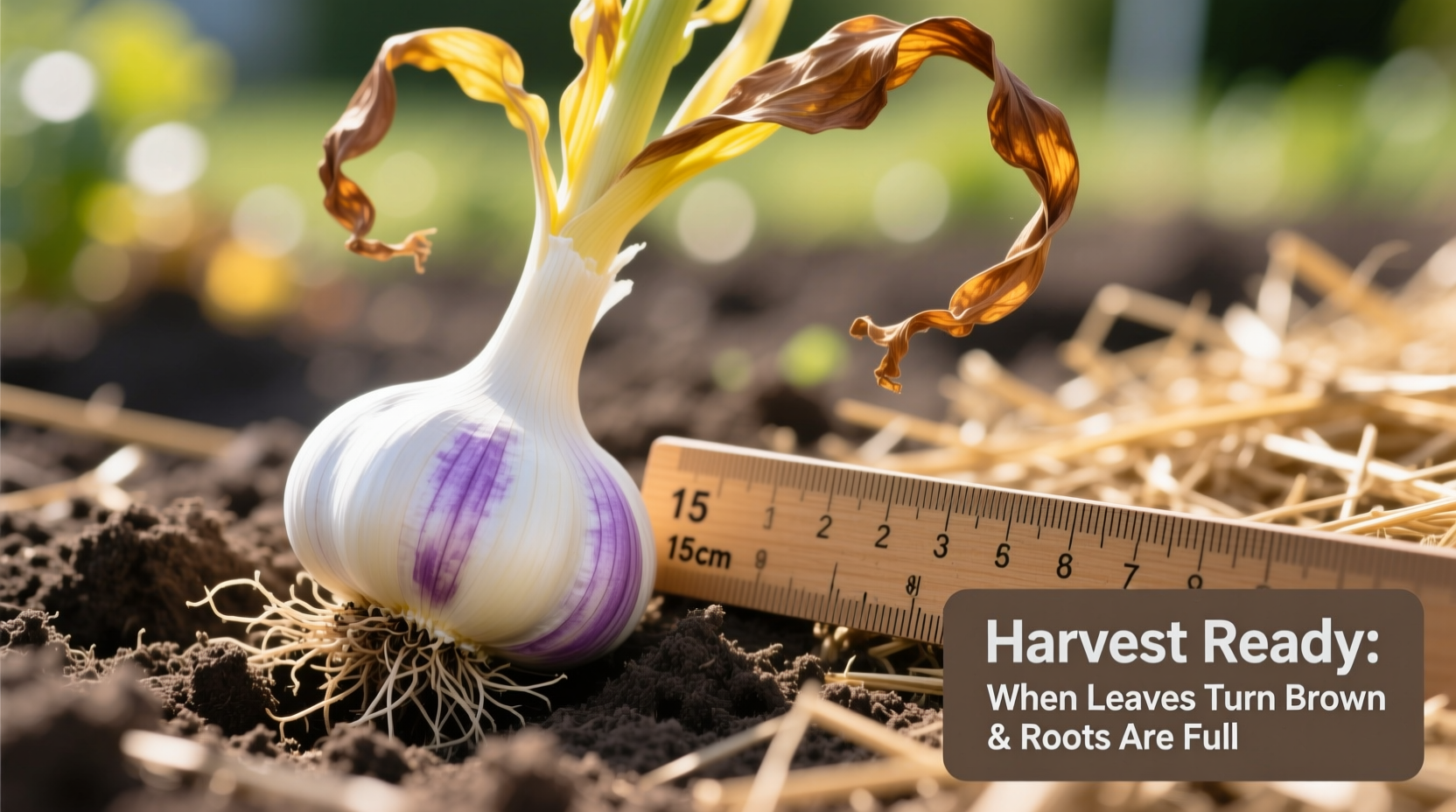Garlic is ready to harvest when approximately one-third to one-half of the leaves have turned brown while the upper leaves remain green, typically 7-8 months after planting. The bulb wrappers should be tight and papery, and individual cloves should be clearly defined but still held together firmly. Harvest timing varies by garlic type and climate zone, with hardneck varieties usually ready in late spring to early summer and softneck varieties in mid to late summer.
Getting the harvest timing perfect makes all the difference between plump, well-formed bulbs and disappointing results. Harvest too early, and your garlic won't reach full size. Wait too long, and the bulbs will begin to split open, reducing storage life. Let's explore exactly how to determine that perfect harvest moment for your homegrown garlic.
Why Garlic Harvest Timing Matters
Garlic continues developing underground even as the leaves begin to die back. The green leaves are actively photosynthesizing and sending energy to the bulb. When approximately 40% of the leaves have turned brown while the top half remain green, the bulb has typically reached maximum size but hasn't started to deteriorate.
According to research from the Oregon State University Extension Service, harvesting garlic at the optimal stage can increase bulb size by up to 25% compared to early harvesting. Conversely, bulbs left in the ground too long may split their protective wrappers, making them vulnerable to disease and significantly reducing storage potential.
Key Visual Indicators of Garlic Readiness
While calendar dates provide a general guideline, the most reliable harvest indicators come from observing your plants directly. Here's what to look for:
| Indicator | Ready to Harvest | Not Ready Yet | Too Late |
|---|---|---|---|
| Leaf Condition | 1/3 to 1/2 brown, upper leaves green | More than 2/3 green | Most leaves completely brown/dry |
| Bulb Wrapper | Tight, papery, intact | Thin, moist, translucent | Splitting, deteriorating |
| Clove Definition | Clear segments, firm | Indistinct, mushy | Separating, loose cloves |
Hardneck vs Softneck Garlic: Different Harvest Signals
Understanding your garlic variety is crucial for proper timing. The two main types show slightly different readiness signs:
Hardneck Garlic (common in cooler climates): Watch for the scape (flower stalk) to straighten after curling. When the scape becomes stiff and the bottom 3-4 leaves turn brown while 4-5 upper leaves remain green, it's time to harvest. Hardnecks typically mature 1-2 weeks before softnecks.
Softneck Garlic (common in warmer climates): These lack scapes, so rely more heavily on leaf condition. Harvest when the top half of leaves are green but the lower third have turned brown and begun to flop over. Softnecks often stay in the ground longer than hardnecks.

Regional Timing Guidelines for Garlic Harvest
While visual indicators are most reliable, these general timeframes can help you anticipate harvest season in your area:
- Northern Zones (3-5): Late June to early July for hardnecks; mid-July to early August for softnecks
- Middle Zones (6-7): Early to mid-July for hardnecks; late July to mid-August for softnecks
- Southern Zones (8-10): Late April to May for hardnecks; May to June for softnecks
The Old Farmer's Almanac notes that garlic planted in fall typically matures in 7-8 months, while spring-planted garlic takes 4-5 months to reach harvest readiness. Local microclimates and seasonal weather variations can shift these dates by 1-3 weeks.
The Test Dig Method: Confirming Harvest Readiness
Before harvesting your entire crop, perform a test dig to verify readiness:
- Select 2-3 representative plants from different areas of your patch
- Carefully loosen the soil around the bulb with a garden fork
- Gently lift the bulb from the ground
- Examine the wrapper condition and clove formation
- Replant any test bulbs that aren't ready (they'll continue developing)
This low-risk verification method prevents premature harvesting of your entire crop. The University of California Cooperative Extension recommends this approach as the most reliable way to determine exact harvest timing for your specific growing conditions.
Proper Garlic Harvesting Technique
When your garlic shows all the readiness signs, follow these steps for optimal results:
- Choose a dry day for harvesting (at least 3 days after rain)
- Loosen soil around plants with a garden fork, working 6 inches from the stalk
- Lift bulbs gently, avoiding bruising or puncturing
- Shake off excess soil (don't wash bulbs at this stage)
- Leave stems attached for proper curing
Never pull garlic directly from the ground by the leaves, as this can damage the bulb and separate cloves. The Royal Horticultural Society emphasizes that careful handling during harvest significantly extends storage life.
What to Do Immediately After Harvest
Proper post-harvest handling is just as important as timing your harvest correctly:
Curing is essential for long-term storage. Place harvested garlic in a single layer in a warm (75-85°F), dry, shaded area with good air circulation. A covered porch, garage, or shed works well. Allow to cure for 2-3 weeks until the outer wrappers become papery and the roots are dry.
Trim roots to 1/4 inch and cut stems to 1-2 inches above the bulb once fully cured. Store in mesh bags or open baskets in a cool (55-65°F), dark, dry place with moderate humidity (60-70%). Properly cured and stored garlic can last 6-12 months depending on variety.
Troubleshooting Common Harvest Issues
Harvested too early? Bulbs will be small with thin wrappers. They'll still be edible but won't store as long. Use these first.
Harvested too late? If bulbs have started to split, use them immediately as they won't store well. For slightly late harvests, cure thoroughly and use within 2-3 months.
Wet weather during harvest? If rain is imminent, harvest anyway and cure indoors with extra ventilation to prevent mold.
Remember that garlic continues to develop right up until harvest, so checking your plants every few days during the critical window ensures you catch that perfect moment when your bulbs have reached maximum size but haven't begun to deteriorate.











 浙公网安备
33010002000092号
浙公网安备
33010002000092号 浙B2-20120091-4
浙B2-20120091-4